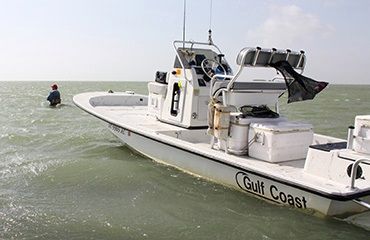Visiting anglers commonly wonder why Texas flats fishermen so frequently get out of perfectly good boats to wade-fish in water that is waist deep or even chest deep. While the question certainly is valid, there truly is a method to the madness, and at times wading is simply the most efficient way to work an area.

The flats in many bays along the Texas coast truly are flat. Expansive areas are only a few feet deep, with widespread grass but very few noteworthy features to concentrate speckled trout, redfish or flounder. Some fish congregate along shallow edges and channel drops; however, most spread across vast flats, relating to countless potholes that might be only 6 inches deeper than the areas around them.
Lacking rips or marsh drains to anchor beside or defined edges to work, most anglers either let their boats drift in the wind and cast downstream as they go or spread out in a line and wade. Either approach allows anglers to continually cover new water in search of feeding fish. For the wading approach, the boat simply serves as a shuttle to get to good areas.
Drifting
Staying in a boat and drifting allows anglers to keep multiple rods and plenty of gear handy and to work together landing fish. If the boat has a GPS, they also can easily repeat a drift or a section of a drift that produces really well. A boat also provide a higher vantage for seeing little potholes and gaps in the grass, where fish are most apt to be.
Beyond strategical differences, some folks simply don’t like walking through the water all day to fish or lack the fitness to do so. Others, understandably, are deterred by the notion of wading with stingrays and sharks.
Wading
Drifting benefits acknowledges, effective drift fishing calls for the right wind conditions. The wind must be blowing enough to carry the boat across a flat but not so quickly that it blows the boat past the fish and makes good presentations difficult. The wind also needs to blow in a direction that is conductive to setting up a good drift. When the wind isn’t right, wading might be a better choice.
Wading also allows anglers to spread over a broader area to find fish. While a drifting group’s casting swath is only a boat-length wide, four wading anglers who each spread 30 feet from one another cover an area that’s nearly 100 feet across. Waders normally stay roughly in a line, moving gradually forward together to work a flat. When one angler catches a couple of fish in a row, which suggests a significant pot hole a cast’s length ahead, the others can move closer to get in on the action.
Closely related, when a drifter hooks a fish, the boat has normally drifted past the spot by the time the fish is releases, so no one ever knows it if the fish came from a hole with several fish in it.
Lure Selection
For either approach, two of the best offerings are a Badonk-A-Donk and a soft-plastic minnow rigged on a Bomber Shad-Head Jig-Head. Either suggests the forage that most gamefish are using and can be moved along steadily to find active fish. Both also work well for fishing over submerged grass, which covers many of the most productive flats along the Texas coast. A good strategy most days is to keep both handy and let the fish reveal their preferences.
